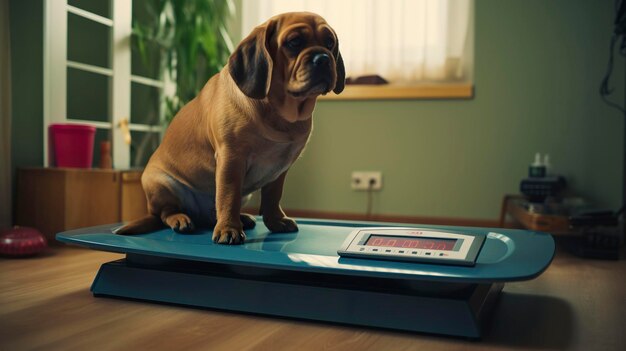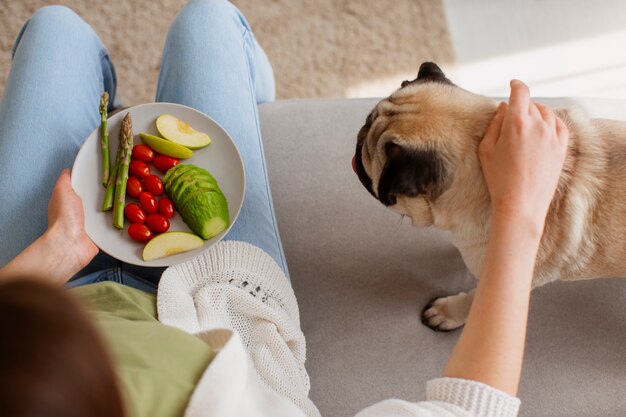5 Simple Steps to Help You Manage Your Dog’s Weight: A Comprehensive Guide
Managing your dog’s weight is an essential part of maintaining their overall health and happiness. An excess pound here and there may not seem like much, but it can lead to a range of health issues, including joint problems, heart disease, and diabetes. Here are five simple steps to help you get started on your dog’s weight management journey.
Step 1: Assess Your Dog’s Current Weight
The first step in managing your dog’s weight is to determine their current weight. Use a reliable pet weight chart to compare your dog’s weight to the recommended range for their breed and size. You can also ask your veterinarian for their professional opinion during your next appointment.
Step 2: Monitor Your Dog’s Food Intake
One of the most effective ways to manage your dog’s weight is by monitoring their food intake. Keep track of how much and how often you are feeding them, and consider measuring out their food using a measuring cup or food dispenser to ensure consistent portions.
Pro Tip:
Break up larger meals into smaller, more frequent feedings throughout the day. This can help keep your dog feeling full while preventing them from overeating during mealtimes.
Step 3: Exercise Your Dog Regularly
Regular exercise is essential for maintaining a healthy weight in dogs. Aim for at least one hour of moderate-intensity physical activity each day, such as brisk walks or playtime with interactive toys.
Pro Tip:
Incorporate fun activities like swimming, hiking, or agility training into your dog’s exercise routine to keep things interesting and engaging.
Step 4: Limit Treats and Table Scraps
Treats and table scraps can add a significant number of calories to your dog’s diet. Instead, opt for low-calorie options like fresh fruits and vegetables or specially formulated training treats. When offering treats, be mindful of portion sizes and consider subtracting calories from their regular meal plan accordingly.
Pro Tip:
Use treats as rewards during training sessions instead of giving them freely throughout the day to help minimize excess calories.
Step 5: Consult with Your Veterinarian
If you are concerned about your dog’s weight or have difficulty managing their diet and exercise routine on your own, consult with your veterinarian for professional advice. They can provide personalized recommendations based on your dog’s unique needs and help you develop a weight management plan tailored to their specific situation.

Maintaining a Healthy Weight for Your Dog: A Comprehensive Guide
Introduction:
A healthy weight is crucial for
dogs
‘ overall health and longevity.
Carrying excess weight can lead to a multitude of
obesity-related health issues
, including joint problems, respiratory difficulties, and cardiovascular disease. Furthermore, maintaining an optimal weight can help to
improve your pet’s quality of life
, ensuring they have the energy and vitality to enjoy their daily activities.
Purpose and Benefits of This Guide:
This comprehensive guide has been designed to provide pet owners with
easy-to-follow steps for managing their dog’s weight
. By implementing the strategies outlined within, you will be able to:
Support your dog’s health and wellbeing
Enhance the bond between you and your pet
Provide valuable knowledge to ensure a long, healthy life for your beloved companion
By learning how to effectively manage your dog’s weight, you will not only be contributing to their health and happiness but also fostering a stronger bond between you and your beloved pet.
Disclaimer: Always consult with your veterinarian for any concerns regarding your dog’s weight and health.

Step 1: Determining your dog’s ideal weight is an essential aspect of ensuring their overall health and well-being. The first step involves calculating your dog’s recommended weight based on their breed, age, and size.
Calculating Your Dog’s Ideal Weight:
You can consult with a veterinarian for an accurate assessment. They will consider various factors, including your dog’s breed standard weight range and any underlying health conditions. Alternatively, you can use an link that uses breed, age, and size as determining factors.
Factors Affecting Ideal Weight:
Breed: Different dog breeds have unique nutritional requirements and ideal weights. For instance, a Toy Poodle weighing 10 pounds is underweight for its breed standard.
Age: Older dogs may need fewer calories due to decreased activity levels, while growing puppies require more food for proper development.
Size: Size refers to the dog’s height and length, not just weight. For example, a Greyhound is a large breed that can weigh between 65-70 pounds but remains relatively slender due to its long body.
Monitoring Your Dog’s Weight:
Regularly monitoring your dog’s weight is crucial for maintaining their optimal health. Use a weight chart or tape measure to track progress at home.
Importance of Regular Check-ups:
Schedule regular veterinary check-ups to ensure accurate weight tracking and detect any potential health concerns early. Remember, a healthy weight can contribute significantly to your dog’s longevity and quality of life.

I Step 2: Assess Your Dog’s Current Diet
Evaluate your dog’s current food intake and nutritional needs:
Before making any changes to your dog’s diet, it’s crucial to evaluate their current food intake and nutritional needs. Here are some steps to help you get started:
Read and understand the label on the dog food package:
a. Ingredient list: Start by looking at the ingredient list. The first few ingredients make up the majority of the food. A quality dog food will have named meat sources, such as chicken, beef, or fish, listed at the beginning.
b. Nutrient information: Check the nutrient information to ensure your dog is getting adequate levels of protein, fat, fiber, vitamins, and minerals.
Determine if any dietary adjustments are necessary to support weight management:
a. Consult a veterinarian for advice on proper portion sizes and caloric intake:
If your dog is overweight or underweight, you may need to adjust their food intake. Consulting a veterinarian can help ensure that any dietary changes are safe and effective for your pet’s unique needs.

Step 3: Implement a Consistent Exercise Routine
A consistent exercise routine is crucial for maintaining your dog’s overall health and wellbeing. Establishing a regular exercise schedule is an essential component of this routine. Here are some guidelines to help you get started:
A.1 Incorporate a Variety of Activities
Your dog will benefit from a variety of activities to keep things interesting and prevent boredom. Some ideas include:
- Walking: This is a great way to bond with your dog and provide mental stimulation. Aim for at least one long walk per day, and supplement with shorter walks throughout the day if needed.
- Playing: Interactive games like fetch or hide-and-seek can help improve your dog’s physical and cognitive abilities.
- Swimming: If your dog enjoys water, swimming is an excellent low-impact activity that can help build endurance and strengthen muscles.
A.2 Maintain Consistency
Consistency is key when it comes to managing your dog’s weight and maintaining optimal health. Try to stick to a regular exercise schedule as much as possible, and make adjustments only when necessary:
Based on Breed
Different breeds have varying energy levels and exercise requirements. Do some research to determine the recommended activity level for your dog’s specific breed.
Based on Age
Younger dogs typically require more exercise than older dogs. Be sure to adjust your routine accordingly as your dog ages.
Based on Health Conditions
Certain health conditions may require you to adjust your dog’s exercise routine. Consult with your veterinarian for personalized recommendations.

Step 4: Monitor Your Dog’s Treat Intake
Limit the number and type of treats given to your dog
Limiting the number and type of treats you give to your furry friend is crucial for maintaining their overall health and well-being. Opt for low-calorie, healthy treat options or consider making homemade alternatives using fruits, vegetables, and lean proteins. These choices will not only provide your dog with essential nutrients but also minimize the risk of obesity and related health issues.
Regularly assess the impact of treats on your dog’s overall caloric intake and weight management goals
As a responsible pet owner, it’s essential to regularly assess the impact of treats on your dog’s overall caloric intake and weight management goals. Treats, even those that are healthy, add calories to your dog’s diet. Be mindful of the quantities you give them and adjust accordingly based on their weight progress.
Adjust treat quantities as necessary based on weight progress
To effectively manage your dog’s weight and maintain a healthy lifestyle, it’s essential to make adjustments to treat quantities as necessary. Regularly weigh your dog and consult with your veterinarian to determine the appropriate number of treats per day based on their size, weight, and activity level.

VI. Step 5: Encourage Healthy Eating Habits
Establish a Consistent Feeding Schedule
- Maintain a regular mealtime routine: This helps regulate your dog’s appetite and digestion.
- Encourage healthy eating habits through positive reinforcement and training techniques:
B.1 Use food rewards sparingly during training sessions
Maintain your dog’s caloric balance by using food rewards sparingly during training sessions.
B.2 Make mealtime enjoyable for your dog
- Incorporate interactive feeders or puzzles: This makes mealtime a fun and engaging experience.
- Provide plenty of water: Ensure proper hydration during and between meals.

VI. Conclusion
Managing your dog’s weight is a crucial aspect of their overall health and well-being. By following the steps outlined in this article, you are taking an important first step towards ensuring your furry friend maintains a healthy weight. Regular exercise, balanced nutrition, and
consistent portion control
are essential elements in any weight management plan for dogs. These steps not only help prevent obesity but also promote a longer, healthier life filled with energy and vitality.
Recognizing the importance of your dog’s weight management journey is only the beginning. It’s vital that pet owners consult their veterinarian for personalized advice on their dog’s specific weight management needs. Every dog is unique, and a professional can help tailor a plan that addresses your pet’s individual requirements.
Additional resources
By combining the information provided here with expert advice from a veterinarian, you’ll be well on your way to helping your dog reach and maintain a healthy weight. Remember, every small step you take towards improving your dog’s diet and exercise routine is a significant investment in their future health.
Additional support
Should you have any concerns or need further guidance, don’t hesitate to reach out to your veterinarian, local pet obesity prevention organizations, or consult the resources listed above. Together, we can help ensure that our beloved pets enjoy a long and happy life filled with love and good health.




